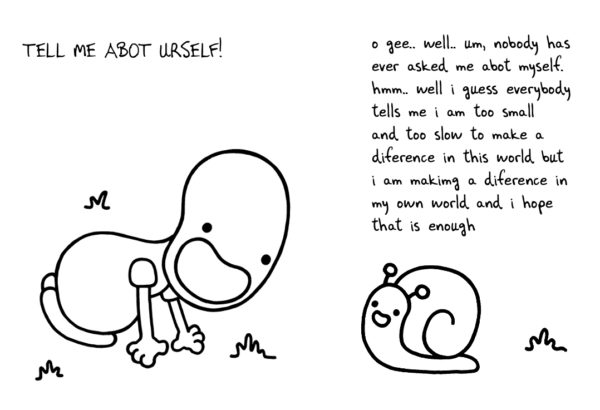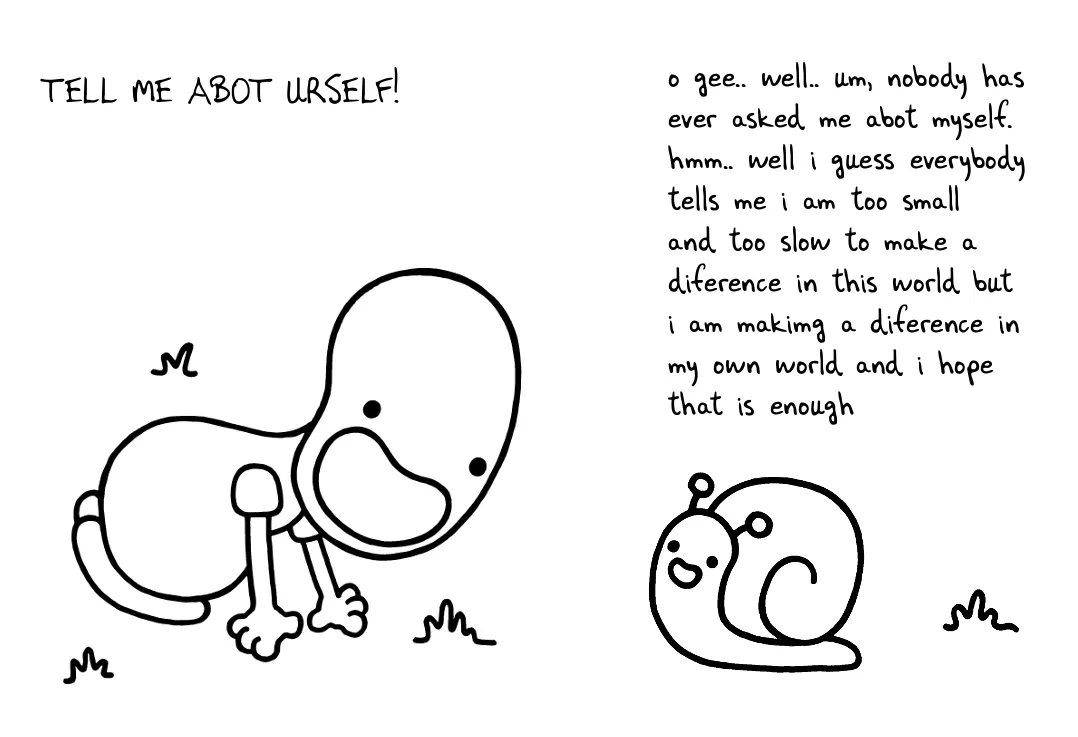
This past June, when I went to Barnes & Noble to pick up Jonny Sun’s new book, ‘everyone’s a aliebn when ur a aliebn too,’ my interaction with the book clerk went a little something like this:
“Hi, do you happen to carry the book, ‘everyone’s a aliebn when ur a aliebn too?’”
“Sorry, could you repeat that?”
“Oh, yeah, of course. It’s ‘everyone’s a aliebn when ur a aliebn too.’”
“Oh, uh, sure.”
“Except everything is misspelled.”
“Pardon?”
“So it’s alien. But with a b. And you’re, except spelled U-R. Oh, and the author’s name is Jonny Sun, but he goes by jomny sun. You know, like Jonny, but instead of a two ‘n’s,’ it’s an ‘m’ followed by an ‘n.’”
And the book clerk, well, she looked at me as if I were “a aliebn.”
For most of us, it’s not an altogether unfamiliar experience to feel like an alien, to feel a sense of, well, ‘unbelonging’ — a lack of togetherness. As a mental health awareness advocate who in the past has grappled with depression and anxiety, author Jonny Sun no stranger to feelings of loneliness and alienation. These feelings are, after all, what prompted him to write this book in the first place.
Sun’s debut novel explores the world through the eyes of a young alien named jomny, who has been sent by his alien colleagues to research humans on earth. But instead of finding humans, jomny discovers some unlikely friends: an egg with a deep-seated fear of hatching, a dog incapable of communicating his innermost thoughts and an elusive, shapeless character named Nothing. Through this strange amalgamation of characters, Sun uncovers universal truths about happiness, sorrow and the vagaries of the human experience, helping everyone — jomny, his friends, and even the readers themselves — feel a little less alien.
The principal metaphor of the book — the alien as a literal manifestation of alienation — is simple, perhaps overt, but this is where the book succeeds. It is through Sun’s simplistic world-building that we begin to understand the complexities of our own world. For instance, Sun’s inclusion of the character, Nothing, is incredibly simple: an entity which embodies silence or fear of the unknown. Yet, Sun utilizes this rather elementary character in an accessible and thought-provoking way. For me, Nothing’s most memorable line is when the character talks about how “being afraid of death is the same as being afraid of nothing.” It is such a simple phrase, but it illuminates our fear of the deep, dark “unknown” in a straightforward, yet powerful manner.
Sun encourages us to consider our greatest fears in the same way a child would and rationalizing them in the same way a child would in order to break these anxieties, as if helping us to dismantle our “adult” fears in a very forgiving and encouraging manner. Wherever there is a moment of poignancy or contemplation such as Nothing’s line regarding the fear of mortality, it is either preceded or undercut by Sun’s witty humor. For example, Nothing’s aforementioned mortality line comes after his first humorous meeting with jomny. Nothing, who at first takes the form of a ghost, brings forth jomny’s fear of dying and of being haunted. Jomny then shrieks upon seeing the ghost-Nothing, to which Nothing replies with “umm i literally experienced the horors of death so maybe this isnt abot you.” Sun’s adroit layering of hilarity and honesty allows him to explore darker themes of death and depression in a way that is somehow light, palatable and refreshing.

‘everyone’s a aliebn when ur a aliebn too’ is full of poignant one-liners from Nothing, jomny and the other creatures of Earth. However, the true power of Sun’s work originates not only from the lines themselves, but also from the way in which they are told. Fraught with calculated misspellings that often involve the insertion of the letter “b” — such as the titular use of “aliebn” — Sun’s book radiates childlike innocence and curiosity. At first glance, it almost seems as though a child has written and illustrated this book, what with the aforementioned misspellings and the rather rudimentary, almost crude, images — jomny himself constitutes a mere bean-shaped head and a tiny, rounded belly connected directly to his oval-shaped feet. But again, the genius is in Sun’s deceptive simplicity.
‘everyone’s a aliebn when ur a aliebn too’ is less of a graphic novel and more of an adult-length children’s book, and this format lends itself well to a unique storytelling experience — one which allows us as readers to reexamine our own lives through a childlike worldview in a way that is unabashedly candid, compassionate and downright adorable. Sun’s ability to properly simplify the complex is perhaps a true testament to his intellect. As a playwright, whose works have been produced at the Yale School of Drama and Factory Theatre; an artist and illustrator, whose pieces have been showcased at MIT and the University of Toronto; as well as a comedy writer, engineer, designer, architect and doctoral student at MIT, Sun is no stranger to the worlds of art and academia. In fact, Sun’s involvement in and understanding of these worlds is what makes him so incredibly relatable, especially to students at Stanford. This is not to say that all Stanford students share the same breadth of experience and talent as Sun; I think we can all agree here that he is more of a fascinating anomaly than a norm or even an attainable standard.
Sun’s relatable nature instead stems from his sensitivity to the academic and social pressures which pervade a great deal of youth culture today. The clever manner in which he is able to rationalize and at the same time poke fun at human fears and anxieties shared among youth is perhaps why Sun has amassed such a large audience on Twitter — now, at nearly half a million followers.
From a college student’s perspective, the most relatable and salient characters are Sun’s egg and owl. Sun’s egg, who is on the one hand afraid of never hatching and on the other fearful that hatching may, in fact, be the greatest and most impossible to replicate moment of his life, communicates the anxieties of many young people today, who find the future to be both a terrifying yet ‘egg-citing’ concept.
The owl, on the other hand, represents an illness which Stanford students know all too well: impostor syndrome. My favorite line of owl’s reads: “…i don’t feel owly enough to be an owl,” a sentiment which has undoubtedly plagued the minds of many students at Stanford and beyond. Sun’s specific use of an owl, the physical manifestation of wisdom, is again a bit of a hackneyed metaphor, but for the purposes of this childlike book, it works unexpectedly well. Additionally, the concept of hiding behind one’s feathers highlights the mask we as burgeoning adults tend to put on as we trudge forth into the workforce and the academic world.
In this unique and expertly crafted novel, Sun’s jomny explores an unfamiliar land, a land which eventually starts to feel like home. Similarly, Sun encourages us, through reading this book, to explore the unfamiliar parts of ourselves — the difficult parts that often go unnoticed, unspoken and unrealized — in order to feel less like aliens and more at home with ourselves.
Contact Alli Cruz at allicruz ‘at’ stanford.edu.
